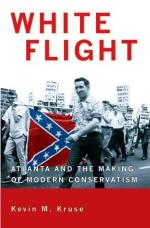|
This section contains 1,115 words (approx. 4 pages at 300 words per page) |

|
White flight refers to the residential movement of whites to avoid self-determined, unacceptable levels of racial integration. Scholars disagree on how much race acts as a singular factor in white migratory decisions, many preferring a natural process called "ecological succession" in which older and less desirable housing stock filters down to lower status classes. The great episodes of neighborhood turnover in the United States after World War II, however, prompted social scientists to focus specifically on race as a "tipping point" that stimulated white exodus to suburbs and newer suburban areas.
White flight was principally a twentieth-century urban phenomenon. Before 1900, ninety percent of African Americans lived in the South. The few black populations in northern cities were small and highly centralized. Occasionally, upper-class blacks intermingled with whites and other ethnic groups. Deteriorating social and economic conditions in the South, including lynchings, led to a mass exodus...
|
This section contains 1,115 words (approx. 4 pages at 300 words per page) |

|


